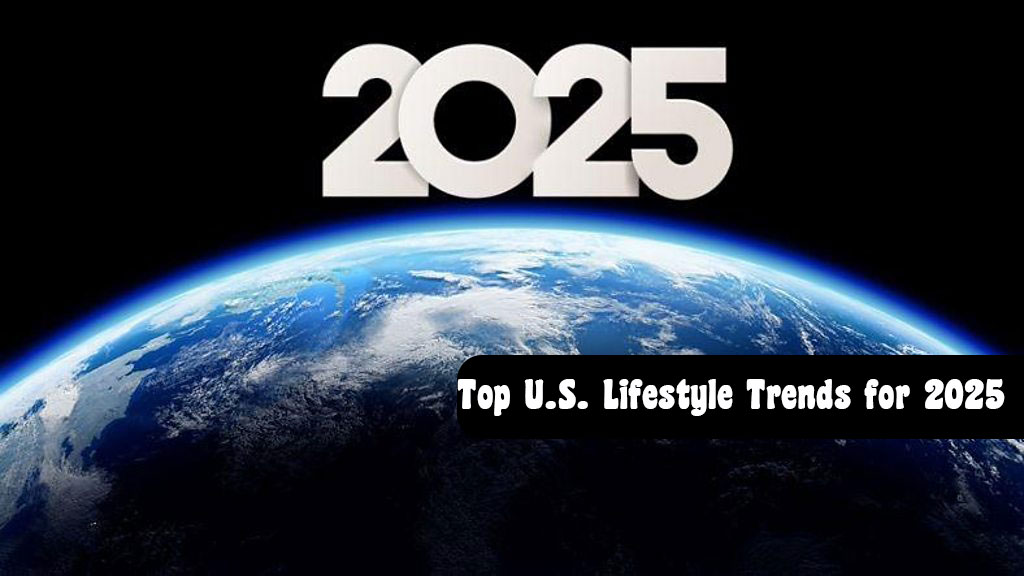
Top-U.S.-Lifestyle-Trends-for-2025
Wellness and Health
Wellness has moved from occasional activity to a daily priority for many Americans. In 2025, the $2 trillion global wellness market is booming, with U.S. consumers spending over $500 billion annually on health and self-caremckinsey.com. Young adults drive this growth: Gen Z and millennials make up just 36% of the U.S. population but account for over 41% of wellness spendingmckinsey.com. Today 84% of U.S. adults say wellness is a top prioritymckinsey.com. They focus not only on physical health (sleep, fitness, nutrition) but also on mental and emotional well-being. Mindfulness, meditation apps, and therapy have become mainstream as people manage high stress – nearly 40% of Gen Z now report feeling “almost always stressed”mckinsey.com.
Younger generations shape wellness definitions. For example, both Gen Z and millennials rank sleep and overall health as their top concerns, but Gen Z places “better appearance” (skin, hair) third, while millennials prioritize mindfulnessmckinsey.com. Gen Z also cares more about sexual health and skincare than older groupsmckinsey.com. This reflects a highly personalized, social-media-driven approach: young people seek products and services that address their specific needs (from cognitive health to holistic nutrition) and expect wellness to be integrated into daily life. Even in uncertain economic times, consumers tend to hold onto wellness spending longer than on other goodsmckinsey.com.

Sustainability and Green Living
Environmental consciousness is a defining trend for 2025 lifestyles. From reusable products to renewable energy, Americans are embracing greener choices. Around two-thirds globally (65%) believe a full transition to clean energy is likely within a decade, and over half expect electric vehicles to dominate future roadsglobescan.com. In the U.S., similar momentum shows in daily habits: recycling, composting, secondhand shopping, and energy-saving home upgrades are more common. However, deep behavior shifts face challenges. Only 40% worldwide think most people will go plant-based in ten years, and just 45% expect most purchases to be secondhand rather than newglobescan.com. This gap suggests policy-driven changes (like renewables) are easier than personal lifestyle changes (like diet).
Businesses are responding: brands highlight eco-friendly credentials to attract customers. Gen Z in particular is driving the market toward sustainability – 64% of Gen Zers say they’d pay more for environmentally sustainable products, and one in four has cut ties with companies that act unsustainablycamphouse.io. This generation expects firms to take public stands on climate and social issuescamphouse.io. In daily life, many Americans now prioritize products with low environmental impact (biodegradable packaging, plant-based materials, ethical sourcing). The rise of smart home IoT also plays a role: analysts project that roughly 57% of U.S. households will own smart home devices by end of 2025demandsage.com, enabling real-time energy monitoring and more efficient use of resources. In short, “green living” is a mainstream 2025 trend: people want products and lifestyles that reduce waste and carbon footprint while still being convenient and stylish.

Remote Work and Work–Life Balance
The pandemic-driven shift to home offices has solidified into a lasting lifestyle change. Before 2020, under 5% of U.S. workers held a remote-compatible job; today roughly 28% work fully remote and 51% in a hybrid arrangementgallup.com. Gallup reports that six in 10 U.S. employees with remote-capable jobs now prefer hybrid schedules, while about one-third want to work completely remotelygallup.com. In practice, surveys show about 35–40% of employees work from home at least part of the week, stabilizing at this level by 2022globalworkplaceanalytics.com. These flexible arrangements remain popular: many workers are willing to trade perks or pay for remote options.
This lifestyle shift blurs personal and professional life, but also offers benefits. Remote work improves work–life balance (no commute stress) and sustains productivity – hybrid employees often report 35–40% higher output than traditional office workersubertrends.com. Companies, in turn, save on real estate and retain talent by supporting flexible policiesubertrends.com. The trend also ties into sustainability: cutting daily commutes significantly reduces carbon emissionsglobalworkplaceanalytics.com. In homes, dedicated office corners and better internet connectivity have become standard features. Overall, flexible, tech-enabled work arrangements are now a foundational 2025 lifestyle expectation in the U.S., especially for younger adults.

Digital Living and Connected Technology
By 2025 the line between online and offline life is even more seamless. Americans are highly connected: an estimated 57% of U.S. households will have smart-home IoT devices (security cameras, smart speakers, smart thermostats, etc.)demandsage.com. Wearables like smartwatches or fitness bands are ubiquitous, and many daily tasks are assisted by apps or voice commands. Experts long ago predicted that the internet would become “like electricity” – invisible but omnipresentpewresearch.org – and today mobile devices and cloud services fulfill that vision.
Key aspects of 2025 digital living include:
-
Smart home integration: Homes have built-in tech for convenience and health. Voice assistants and automated lighting save time and energy, while smart air and sleep monitors support wellnessdarglobal.co.ukurdesignmag.com. Intelligent appliances (refrigerators, ovens, etc.) help plan meals and reduce waste. For security, homes use connected locks, cameras, and sensors for real-time monitoring, all controllable by smartphone.
-
Wearables and health tech: More people use wearables for health and convenience. Smartwatches track fitness, heart rate, and sleep, integrating with health apps. Some home devices even offer meditation or stress biofeedback. This tech ecosystem reinforces the wellness trend by giving people data on their bodies at home.
-
Immersive media and gaming: Virtual reality (VR) and augmented reality (AR) become mainstream entertainment and social platforms. VR headsets are used for gaming, virtual workouts, or even virtual travel experiences. Companies and educators also use AR/VR for training and collaboration, making digital interaction richer.
-
Social media as search: Younger Americans often use TikTok or Instagram instead of Google for lifestyle info. About 40% of Gen Z say they search for recipes, fashion tips, or news on social appscamphouse.io. Influencers and micro-video content thus play a huge role in shaping trends (e.g. a fitness routine or wardrobe idea seen on social media can instantly go viral).
In summary, “digital living” for 2025 means technology is woven into homes and lives. Consumers expect seamless connectivity and personalization: from AI-curated health advice to smart homes that learn family routines. This constant connectivity also accelerates trends (like viral health fads or eco-challenges) and reinforces a culture of on-demand, digitally enabled lifestyles.

Home Design and Smart Spaces
Home décor and architecture reflect 2025’s blended focus on comfort, sustainability, and tech. Interior design is no longer just about looks – it’s about well-being and environmental impact. A major trend is eco-friendly, sustainable materials: reclaimed wood, recycled metals and fabrics, natural stone, and low-VOC paints are popular in walls, furniture, and flooringurdesignmag.com. Products are increasingly designed for a circular economy – for example, modular furniture that can be disassembled for recycling. Zero-waste manufacturing and biodegradable finishes are highlighted by many brands.
Comfort-first design is another key direction. Homes are being arranged as personal retreats that foster mental healthurdesignmag.com. Think warm, layered lighting (no harsh fluorescents), deep and plush seating for relaxation, and soothing color palettes. Biophilic elements – plants, natural textures, views of nature – are incorporated to reduce stress. Interior trends are shifting from stark minimalism to maximalism with purpose: bold patterns and rich colors can appear, but paired with cozy textures and personal touches so the space feels “lived in” rather than sterileurdesignmag.com. Importantly, using higher-quality, longer-lasting décor means people keep items longer, supporting sustainability.
At the same time, smart home technology is built into design so it blends in. Voice-controlled assistants, smart thermostats, and integrated charging stations are now part of layoutsurdesignmag.com. Kitchens and living rooms often include screens or speakers built into cabinetry. Even lighting systems can adapt to your schedule or connect to smartphone apps. In apartments and shared housing, tech improves convenience (digital entry systems, smart-meter billing). Overall, new homes are designed from the ground up to be energy-efficient and tech-enabled – for example, solar panels and home batteries pair with smart monitoring for a greener footprint.
In essence, 2025 home design balances style with purpose. Interiors feel personal and comfortable for wellness, while hidden tech and sustainable choices demonstrate that the modern home supports both lifestyle and environment.

Fashion and Style Trends
Fashion in 2025 emphasizes comfort, versatility, and sustainability. The athleisure and “everyday casual” trend continues strong: workwear has merged with workout gear. High-quality, comfortable clothing (think stretchy knits, breathable fabrics, relaxed silhouettes) is the norm for both home and office. Indeed, one industry analysis found that among luxury activewear buyers, 57% prioritize comfort above all (versus 44% who rank style as their top concern)gwi.com. Notably, weekly athleisure use is highest among millennials (39%) and Gen X (33%), with Gen Z slightly behind (22%)gwi.com – indicating that this comfort-driven style crosses generations.
Sustainable fashion is also a core trend. Consumers expect eco-friendly materials and ethical production. For example, 67% of U.S. shoppers now say it’s important that clothing be made of biodegradable materialslifestylemonitor.cottoninc.com. This fuels demand for plant-based fibers (like organic cotton, hemp, Tencel) and recycled textiles. Brands of all sizes are showcasing “slow fashion” lines made from natural or recycled fabrics. Vintage and secondhand clothing have mainstream appeal, especially among young people who value uniqueness and eco-consciousness. Functional activewear made from recycled plastic bottles or fabrics that easily decompose is gaining market share.
Digital fashion concepts are emerging too: virtual try-ons and even NFT “skins” for avatars are niche interests for tech-savvy consumers. But the core in 2025 is tangible: people want wardrobes that feel good, last long, and look modern. Gender-neutral and unisex styles remain popular (for instance, oversize hoodies, straight-cut pants, and sneakers for everyone), reflecting a broader move toward inclusivity. In color and patterns, expect earthy tones and minimalist aesthetics, occasionally accented by the bold prints seen in maximalist interiors. In sum, 2025 fashion is practical yet purposeful – blending comfort and personal expression with a clear eye on ethical impact.

Gen Z and Millennial Lifestyle Shifts
Generational preferences profoundly shape these trends. Millennials (born 1981–96) and Gen Z (born 1997–2012) are now the largest adult cohorts, and their values drive markets. Both groups prioritize well-being, authenticity, and purpose. In careers, Deloitte finds they seek a “trifecta” of money, meaningful work, and balancedeloitte.com – extending to life choices too. Surveys show around 90% of millennials and Gen Zers say having a sense of purpose is crucial for job satisfactiondeloitte.com, and by extension for brand loyalty and lifestyle alignment.
Gen Z (digital natives) are especially influential. They grew up fully online, so social media and tech trends diffuse rapidly in their circlesmckinsey.com. They tend to be socially progressive, with strong commitments to diversity, equity, and climate action. McKinsey notes that “more than any other generation, Gen Z demands purpose and accountability,” and expects companies to support green practicesmckinsey.com. In consumer choices, 64% say they’ll pay more for sustainable products and 25% will boycott unethical brandscamphouse.io. They also report higher stress and mental health concerns (climate anxiety, career anxiety) than older groupsmckinsey.commckinsey.com, which ties them closely to the wellness trend.
Gen Z is also redefining social norms: their fashion is gender-fluid and eclectic, they use TikTok/Instagram as primary news and shopping channelscamphouse.io, and they view purchases as personal statements. Millennials, while also tech-savvy, are slightly more traditional – many are focused on family life, home ownership, and financial stability, especially as they age into their 30s and 40s. However, millennials share Gen Z’s sustainability and wellness concerns. Both generations are less brand-loyal than older people and more willing to switch to products that align with their values.
In summary, younger Americans are shaping 2025 lifestyles through their values and behaviors. They drive demand for flexible work, eco-friendly products, and digital conveniencecamphouse.iodeloitte.com. At the same time, each generation has nuances: Gen Z skews more casual and social-media-driven, millennials more established and family-oriented. Together, they ensure that personal health, environmental responsibility, and tech integration remain at the heart of U.S. lifestyle trends in 2025.
Sources: Current research and industry reports on U.S. consumer and lifestyle trendsmckinsey.commckinsey.commckinsey.comgallup.comgallup.comglobalworkplaceanalytics.comdemandsage.comglobescan.comglobescan.comlifestylemonitor.cottoninc.comcamphouse.iourdesignmag.comurdesignmag.comgwi.comgwi.com.






